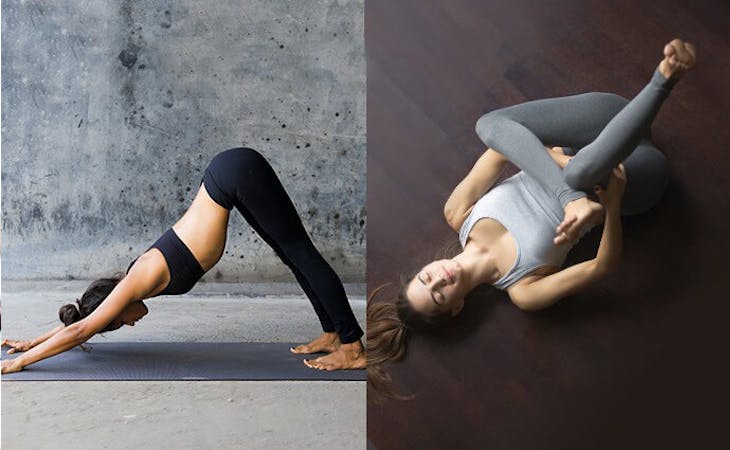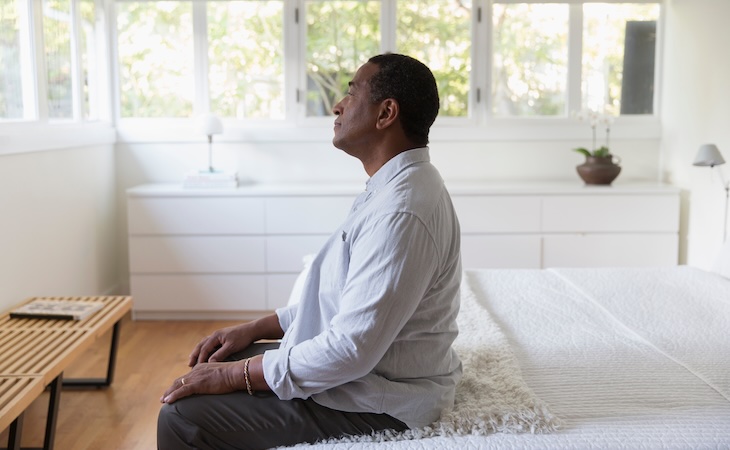Beyond eating foods that will make you tired and shutting off your phone an hour before bed, stretching is another great way to get ready for a good night’s sleep. Kane Sivesind, certified strength and conditioning specialist and owner of CORE Health and Fitness in Wisconsin, explains that our bodies thrive on routine—and a nightly stretching practice can help our bodies understand that it’s time to wind down and head to bed.
The best stretches to do before bed
“Using the following stretches and exercises will not only make you feel better but also help start the flow of sleep hormones, allowing you to fall asleep faster upon hitting the pillow,” Sivesind says.
Child’s pose
Yogis turn to this pose when they’re feeling worn out during class, and for thousands of years, it’s been thought of as a posture that promotes instant relaxation. “Child’s pose is excellent at helping your body relax,” Sivesind explains. “Most of us are stuck in an ‘extension’ pattern in our daily life, and the ability to push air into our back is very beneficial. This is one of the best positions to switch out of fight-or-flight, so it’s a great way to wind down your day.”
How to do the stretch:
- Kneel on the floor.
- Touch your big toes together and sit on your heels. Separate your knees as wide as your hips.
- As you exhale, lower your torso toward the ground. Only go as deep as it feels comfortable.
- Think about lengthening your spine as long as you can.
- Reach your arms out in front of your head, palms down on the floor. Stretch long.
- Hold this position for a count of five to 10 slow inhales and exhales. Try to fill your upper back with air as you inhale.
- You can also reach your arms slightly to the sides to get a deeper side stretch.
Downward dog
This yoga move is a step during sun salutations, but it can also be a great posture for when you’re greeting the moon before bedtime. “Not only does downward dog get an amazing stretch along the backs of your legs, but it will also help you strengthen your core,” Sivesind says. “Add in the shoulder stability, and it’s a great full-body stretch that everyone can benefit from. Taking deep breaths while in the slightly-inverted position can be very beneficial in helping relax your body and get you ready for a quality night’s sleep.”
How to do the stretch:
- Begin on your hands and knees. Align your wrists directly under your shoulders and your knees directly under your hips.
- Spread your fingers wide and press firmly through your palms and knuckles. Distribute your weight evenly across your hands.
- Exhale as you tuck your toes and lift your knees off the floor. Reach your pelvis up toward the ceiling, then draw your sit bones toward the wall behind you. Gently begin to straighten your legs, but do not lock your knees. Bring your body into the shape of an “A.” Imagine your hips and thighs being pulled backward from the top of your thighs. Do not walk your feet closer to your hands—keep the extension of your whole body.
- Press the floor away from you as you lift through your pelvis. As you lengthen your spine, lift your sit bones up toward the ceiling. Now press down equally through your heels and the palms of your hands.
- Hold this position for five to 10 deep inhales and exhales.
- To release, exhale as you gently bend your knees and come back to your hands and knees.
Lying hip stretch
The lying hip stretch is particularly effective if you’re someone who works at a desk all day. “With the amount of sitting we do on a daily basis, our hips are one of the tightest areas in our body,” Sivesind says. “Loosening them up will go a long way in making your whole body feel better. The lying hip stretch is the easiest way to loosen up this area. This stretch can help prevent waking up in the morning with hip pain.”
How to do the stretch:
- Lie on your back on the floor with your left leg bent.
- Cross your right leg over your left, with your right ankle resting on your left knee.
- Slowly lift your left foot off the floor and toward you while you apply gentle pressure to the inside of the right knee.
- Hold for five to 10 slow, deep inhales and exhales.
- Repeat on the other side.
Seated twist
This Pilates exercise is a fantastic way to stretch your body. “An active rotation where you have to use the muscles in your torso to move each segment of your spine into rotation creates a combination of strengthening, stretching, and increased blood and lymph flow in the muscles of your torso,” says Heidi Folkerds, owner of Minnesota’s Lumos 7 Pilates. “This combination promotes muscle relaxation as you lie down for bed.”
How to do the stretch:
- Sit on the floor or propped on a towel or block if you have tight hamstrings or hips.
- Reach your arms forward in a V-shape.
- Inhale, sit taller, exhale, and rotate from your ribcage to the right. Feel your core creating the twist, keeping your arms in the V-shape.
- Inhale, return to center, exhale, and rotate from your ribcage to the left. Repeat three times each side, twisting a little further each time.
Qigong is an ancient practice that combines mindfulness with light stretching. Learn about the sleep and health benefits of qigong.




